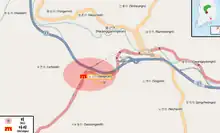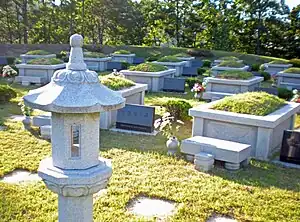Nogeun-ri
Nogeun-ri, also No Gun Ri, is a village in Hwanggan-myeon, Yeongdong County, North Chungcheong Province in central South Korea. The village was the closest named place to the site of the No Gun Ri Massacre (July 26–29, 1950) during the Korean War, in which the U.S. military killed South Korean civilians fleeing their nearby villages.[1][2] A South Korean government committee in 2005 certified the names of 163 dead and missing and 55 wounded, and said many other victims' names were never reported.[3][4]: 277–281
| Nogeun-ri | |
 Map of NoGeun-Ri | |
| Korean name | |
|---|---|
| Hangul | 노근리 |
| Hanja | 老斤里 |
| Revised Romanization | Nogeun-ri |
| McCune–Reischauer | Nogŭn-ri |
The South Korean government-funded No Gun Ri Peace Foundation, which operates a memorial park at the massacre site, estimated in 2011 that 250–300 were killed, mostly women and children.[5]

Korean records show Nogeun-ri as a very old village, its earliest mention coming in 11th-century sources. Gazetteers say the village was laid waste during the 16th-century invasions of Japanese shogun Hideyoshi.[6] At the time of the Korean War massacre, it was in a typical Korean rice-growing area, but many fields were converted to vineyards in later years.[7]
An act of the National Assembly in 2004 called for building the memorial park at the massacre site, which had begun attracting 20,000 to 30,000 visitors a year. The 33-acre (13-ha.) No Gun Ri Memorial Peace Park, built with $17 million in government funds and featuring a memorial, museum and peace education center, opened in October 2011.[4]: 219, 190, 311–312 [8] In 2009, Yeongdong County established a nearby cemetery to which some victims' remains were moved from family plots.[9] The 8th International Conference for Museums of Peace was held at the park in September 2014.[10]

References
- Choe, Sang-hun, and Charles Hanley, Ex-GIs Tell AP of Korea Killings, Sept. 30, 1999.
- Clinton, Bill, "No Gun Ri: Clinton's Statement", January 11, 2001.
- "218 victims of No Gun Ri incident confirmed". Hankook Ilbo (in Korean). May 23, 2005. Retrieved August 31, 2012.
- Committee for the Review and Restoration of Honor for the No Gun Ri Victims (2009). No Gun Ri Incident Victim Review Report. Seoul: Government of the Republic of Korea. ISBN 978-89-957925-1-3.
- Lee, B-C (October 15, 2012). "노근리재단, 과거사 특별법 제정 세미나 개최" [No Gun Ri Foundation held special law seminar]. Newsis (online news agency) (in Korean). Seoul. Retrieved June 2, 2015.
- Cumings, Bruce (2001). "An Occurrence at No Gun Ri Bridge". Critical Asian Studies. 33 (4): 513. Retrieved August 31, 2012.
- Hanley, Charles J.; Choe, Sang-Hun; Mendoza, Martha (2001). The Bridge at No Gun Ri. New York, New York: Henry Holt and Company. pp. 265. ISBN 0-8050-6658-6.
- "Gov't to build memorial park for victims of Nogeun-ri massacre". Yonhap news agency. March 22, 2007. Retrieved March 10, 2012.
- "No Gun Ri victims cemetery completed". Yonhap News Agency (in Korean). June 23, 2009. Retrieved August 31, 2012.
- International Network of Museums for Peace (November 2014). "8th International Conference of Museums for Peace" (PDF). Newsletter No. 9. Retrieved October 10, 2015.
Further reading
- "Report of the No Gun Ri Review". U.S. Department of Army Inspector General, January 2001. Retrieved August 31, 2012.
- "Committee for the Review and Restoration of Honor for the No Gun Ri Victims (2009). No Gun Ri Incident Victim Review Report. Seoul: Government of the Republic of Korea. ISBN 978-89-957925-1-3.
- Ministry of Defense, Republic of Korea. The Report of the Findings on the No Gun Ri Incident. Seoul, South Korea. January 2001.